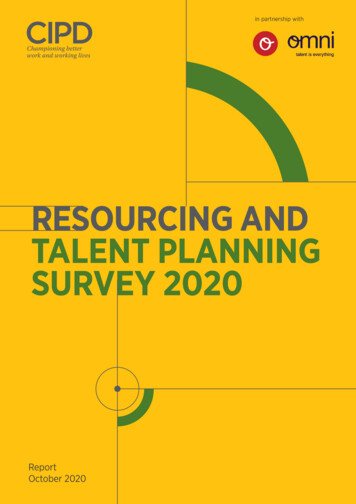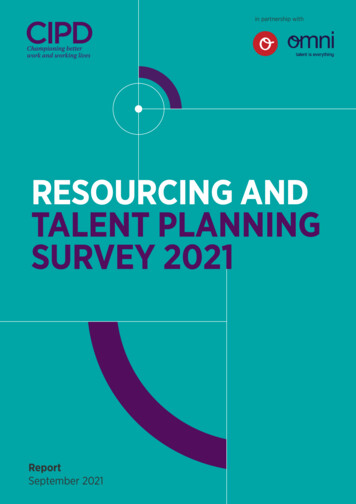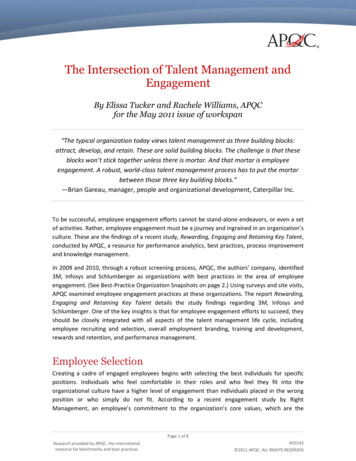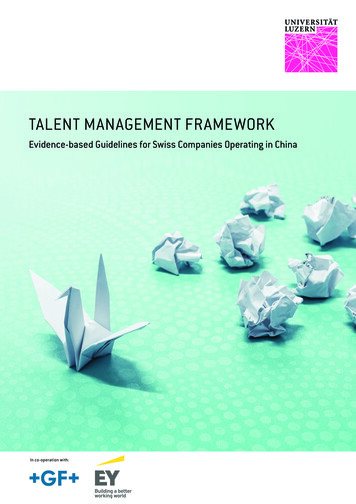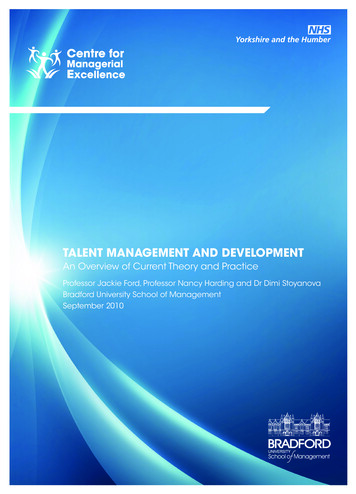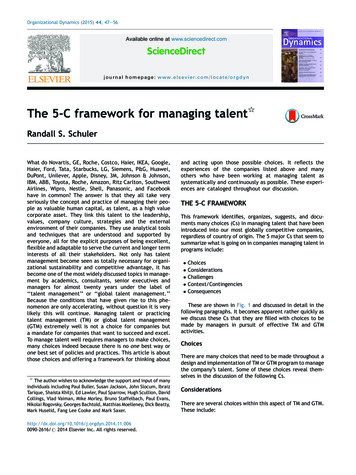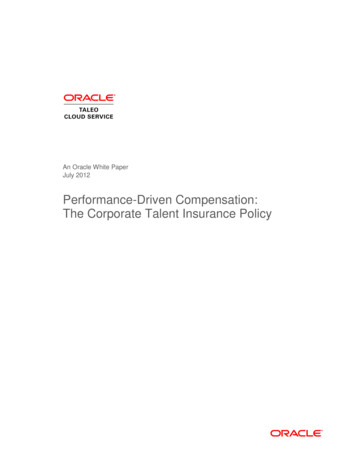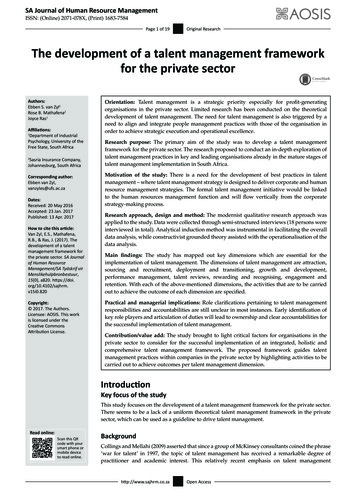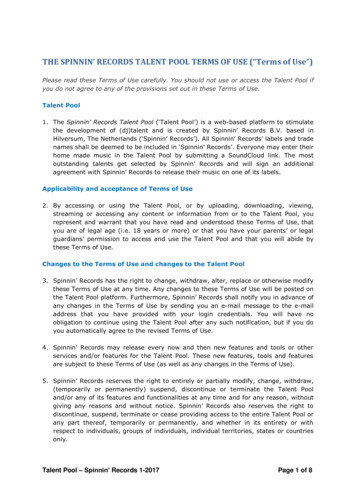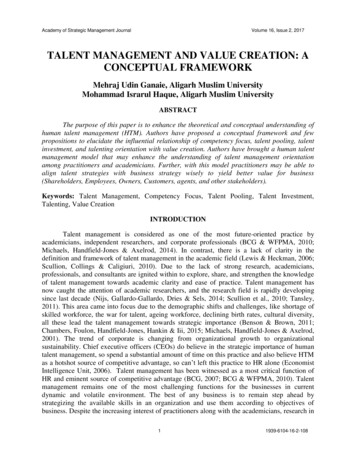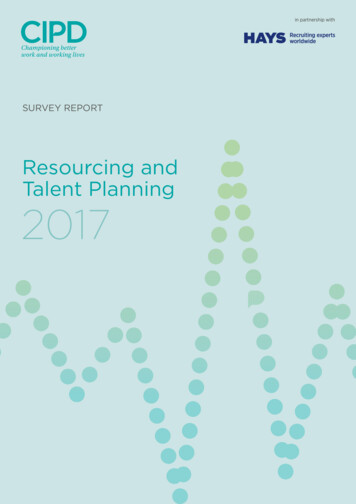
Transcription
in partnership withSURVEY REPORTResourcing andTalent Planning2017
The CIPD is the professional body for HR and peopledevelopment. The not-for-profit organisation championsbetter work and working lives and has been setting thebenchmark for excellence in people and organisationdevelopment for more than 100 years. It has more than140,000 members across the world, provides thoughtleadership through independent research on the world ofwork, and offers professional training and accreditation forthose working in HR and learning and development.
Resourcing and talent planningSurvey report 2017ContentsForeword from the CIPD2Foreword from Hays3Summary of key findings4Resourcing and talent practices in the current economic and political climate6Recruiting: the numbers12Attraction strategies17Selection and candidate behaviour27Recruitment difficulties31Talent management, retention and turnover38Conclusions43Background to survey46Endnotes49AcknowledgementsThe CIPD is very grateful to those organisations and individuals who gave their time to take part inthis research. They include: all those who completed the surveyLiz Dalton, CIPD, for creating the survey onlineAnnette Sinclair, research consultant, for analysing the findingsClaire McCartney, Associate Research Adviser at the CIPD, for writing the reportBen Morrin, Director of Workforce at UCLH, and Jon Dawson, former HR Director at The EDITIONand now HR Director at The Mandarin Oriental, Hyde Park, London, for providing case studiesresourcing and talent professionals from the CIPD’s RTP ForumHays, for their support and commitment throughout the research.We hope that you find the research useful when considering your own resourcing and talent planningpractices.Please contact us if you have any questions or ideas based on our findings: planningsurvey
Foreword from the CIPDThe Resourcing and TalentPlanning survey is now in itstwentieth year. It is a valuedsurvey with a sample this yearof over 1,000 HR professionals.This research provides HRprofessionals and theirorganisations with benchmarkingdata on recruitment costs,resourcing and talentmanagement practice, employeeturnover and retention.This is a particularly interestingtime to be conducting thisresearch given that the past yearhas seen political and economicchanges on a global scale. Therehave been political surprises inboth the UK with the vote toleave the EU and in the US withthe success of Donald Trump.Continued political uncertaintylooks set to impact the way inwhich organisations attract andretain talent.Our survey shows thatorganisations are currentlymaintaining a dual focus onrecruiting key talent, while alsodeveloping more talent in-house.Organisations are experiencinggrowing competition for talentand are increasingly recognisingthat the skills needed for jobs intheir organisations are changing.Following the UK’s decision toleave the EU, organisations reporta greater emphasis on developingexisting staff, increasedcommunications and opportunitiesto listen to employees, as well asmore candidate and organisationcautiousness in recruiting. Looking2forward, organisations anticipatethe biggest changes in the nextthree years will be increasingcompetition for well-qualifiedtalent, developing existing staffand difficulty recruiting senior andskilled employees. It is thereforemore important than ever thatorganisations remain alert to thepotential changes and agile intheir response to these in orderto continue to attract and retainpeople with the best skills andpotential for their business needs.Moving forward, organisationsneed to continue to develop athorough understanding of theirexisting talent profile and theircurrent and future requirements.Targeting resources effectivelywill remain a priority throughthis period of wider economicand political instability. Ongoingmonitoring and evaluation will bekey to ensure that the methodsused to attract, select and retainemployees are effective and fit forpurpose.Reassuringly, there is evidencein the survey of organisationsmaking use of a number ofeffective recruitment channels.The research also suggests arenewed focus by organisationson building an attractive employerbrand and of practices to supportthe upskilling and developmentof existing staff. More work,however, is needed when itcomes to delivering on diversity,sharpening a focus on retentionand measuring the effectivenessand return on investment ofrecruitment and talent practices(all outlined in further detail in theconclusion).Claire McCartneyAssociate Research Adviser, CIPDAt the CIPD we believe that HRand L&D professionals shouldbe using Brexit as a stimulusfor applying focus to what weshould already be doing as aneconomy and society: to getthe fundamentals right, to builda stronger, more productiveworkforce, and to createworkforces that engender growthand inclusiveness.Resourcing and Talent Planning Survey 2017
Foreword from HaysWe are pleased to once againpartner with the CIPD on thisreport, which provides invaluableinsight into resourcing andtalent planning and the currentchallenges for organisations.Given the wide-ranging politicaland economic changes the UKhas faced recently, this research isparticularly pertinent.We are of course pleased to seethat this year’s report providesevidence of organisations makinggreater use of recruitmentchannels, that recruitment budgetsare set to increase and thatthere is an increasing trend tocombine in-house and outsourcedrecruitment approaches.Given the vast skills shortagesthe UK is faced with, targetedrecruitment to source these ‘hardto-find’ skills will be even moreessential, particularly in light ofpotential changes to immigration.In line with our own researchin the Hays Salary & RecruitingTrends guide, this survey showedthat competition for well-qualifiedtalent has increased and is set toincrease further over the comingyear as the shortages intensify.It is therefore encouraging thatorganisations are placing arenewed focus on improving theiremployer brands. Given that anorganisation’s reputation is criticalwhen attracting staff, this shouldn’tbe underestimated. Organisationsshould also be looking at whattraining and developmentopportunities they offer staff andhow they are promoting these to3potential new recruits. This wassupported by the survey findingsand is likely to grow in importanceas professionals focus on careerprogression and employers want tonurture loyalty.About usAt Hays, our passion lies inhelping people to develop theircareers, and employers to growtheir organisations with the rightpeople.Despite some positive findings, it issurprising that fewer organisationshave a formal diversity strategyand that this number has reducedcompared with previous years.It highlights how much progressorganisations still have to makebefore diversity is fully ingrainedand they are seeing the benefits,particularly organisations that arein sectors that don’t yet reflect thediversity of their customers andare plagued by skills shortages.Our worldwide team covers250 offices across 33 countries,with more than 2,000 expertsbased in the UK. We recruit fortemporary and permanent rolesfor organisations of all sizes, andour global reach combined withlocal knowledge means we trulyunderstand the needs of those wework with. We provide expertiseacross a wide spectrum ofindustries and sectors.We hope this report provides youwith useful information to guideyour resourcing decisions and lookforward to discussing the findingswith you.Nigel HeapManaging Director Hays UK &IrelandOur market-leading databaseenables our consultants to searchover 4 million candidates globally.We are also the Most SociallyEngaged Global RecruitmentCompany on LinkedIn , as wellas the most followed recruitmentcompany with over 1.5 millionfollowers. These networks giveemployers access to the widestpossible talent pool and increaseour chances of finding the rightmatch for your organisation.Working closely with ourcustomers, we manage the entirerecruitment process, carryingout in-depth assessments ofcandidates to ensure we deliveroutstanding anningsurvey
Summary of key findingsThe CIPD’s Resourcing and Talent Planning survey, in partnership with Hays, examinesresourcing and talent planning strategies and the key challenges that organisationsface. The 2017 survey report is based on responses from 1,068 people.Resourcing and talent practices‘In 2017,in the current economic andpolitical climateorganisations In 2016, seven in tenanticipate a greater organisations have focusedrecruitment and talentfocus on developing theirpractices on recruiting for keyareas. Almost halfmore talent in-house.’ talent/nichehave developed more talent 4in-house and used new media/technology to recruit.In 2017, organisations anticipatea greater focus on developingmore talent in-house andan increase in both focusingmore on retaining rather thanrecruiting talent and investingmore time and effort in thequality of candidates.When it comes to views on theemployment market, over fourfifths of organisations maintainthat competition for wellqualified talent has increasedover the past year and nearlytwo-thirds believe that theskills needed for jobs in theirorganisations are changing.Following the UK’s decisionto leave the EU, organisationsreport a greater emphasis ondeveloping existing staff (26%),increased communicationsto employees about theorganisation’s strategy(22%), opportunities to listento employees (21%), andmore candidate (20%) andorganisation cautiousness inrecruiting (21%).Anticipated changes includeincreasing competition forwell-qualified talent (72%),developing existing staff (68%) and difficulty recruiting seniorand skilled employees (61%).Over a quarter of organisationspredict that recruitment intheir organisation will increaseas a direct result of theapprenticeship levy, with thisfigure rising further in the publicsector and larger organisations.Recruiting: the numbers Just over a quarter oforganisations say theirrecruitment budgets willincrease and a third say theirtalent management budgets willdo the same in 2017–18. Privatesector organisations are morelikely than the other sectors tosay both their recruitment andtalent management budgets willincrease in 2017–18. The median number ofpermanent (20) and short-term(4) vacancies filled in the last yearremains the same as 2014–15. The median cost for hiringsenior managers/directors hasdecreased from our last surveyand is 6,000. The cost for allemployees has remained thesame at 2,000. Over half conduct allrecruitment activity in-house,but there is an increasingtrend to combine in-house andoutsourced approaches (2017:44%; 2015: 40%; 2013: 28%). Less than a fifth currentlymeasure the return oninvestment (ROI) of theirrecruitment activity. By far themost popular method is costper hire (81%), followed byResourcing and Talent Planning Survey 2017
the turnover rate of new hires(75%). Half also assess theperformance of their new hiresas part of their ROI activities.Far fewer assess the quality ofsource, candidate satisfactionand interviews per hire.Attraction strategies Organisations are placing arenewed focus on improvingtheir employer brands, withalmost nine in ten makingefforts to improve it in the lastyear. Organisational valuesare seen as most important toattracting candidates, followedjointly by career developmentopportunities and pay andbenefits. The most effective methods forrecruiting are own corporatewebsites (74%), followedby professional networkingsites (60%), commercial jobboards (58%) and recruitmentconsultants (52%). Fewer organisations thisyear (just over half) have aformal diversity strategy, andthis proportion has reducedfrom previous years. Themost common methods usedto address diversity issuesare monitoring recruitmentinformation to obtain data ondemographics (73%), traininginterviewers to understand whatdiversity is about (56%) andactively trying to attract talentof all ages (52%). Nearly a third of organisationsbelieve that the currentsystem of education is poor atequipping young people withthe skills their organisationneeds. More organisations this yearare currently offering andplan to offer apprenticeships,presumably influenced bythe introduction of theapprenticeship levy, whichrequires larger UK employers tofund new apprenticeships.5 Graduate recruitmentprogrammes remain steady, withalmost two-fifths operating astructured programme, althoughfewer have increased theirintake compared with 2015.Selection and candidatebehaviour The most popular methodof selection this year iscompetency-based interviews,with just under four-fifthsmaking use of this selectionmethod. However, in generalthe methods used to selectapplicants follow a similarpattern to previous years. An increasing proportion alsomake use of distance interviews,such as telephone (65%) andvideo/Skype (52%), with privatesector organisations most likelyto use these methods. When it comes to candidatebehaviour, the majority ofcandidates arrive promptly forinterviews, behave with sincerityand provide accurate CVs, butthere is room for improvementin the way candidatescommunicate with potentialemployers.Recruitment difficulties Recruitment difficulties remainsubstantial for organisations,with three-quarters havingrecruitment difficulties in thelast year. A tenth of organisationsexperience difficulties recruitingfor more than 50% of theirvacancies. Professionals/specialists (64%)are the roles that have been themost difficult to recruit for overthe last year. Organisations are now mostlikely to reduce recruitmentdifficulties by upskilling existingemployees to fill hard-to-recruitfor positions. However, more than two-fifths(41%) believe the length of their recruitment process has led tothe loss of potential recruits inthe last 12 months.In the next 12 months, thedemand for HR specialists intalent and resourcing (46%) andlearning and development (36%)will increase.Professionals with leadership(58%), digital (54%) andcommercial awareness skills(51%) are likely to increase indemand in the next 12 months.Talent management, retentionand turnover There seems to be a renewedemphasis by organisations ontalent management, with overhalf of CEOs prioritising it andincreasing talent managementbudgets. The median rate of labourturnover has increased againsince our last survey and sits at16.5%. Despite this increase, over halfof organisations do not calculatethe cost of labour turnover.Private sector organisations aremore likely to calculate this thanthe other sectors. More than four-fifths oforganisations had challengesretaining one or more categoryof staff in 2016, and thisrepresents an increase fromprevious years; however, justtwo-fifths of organisationsundertook specific initiatives toimprove staff retention in 2016. The most popular step takento improve staff retention wasthrough increasing learningand development opportunities(57%). This is followed by animproved induction process(56%) and improved ngsurvey
Resourcing and talent practices in thecurrent economic and political climateOrganisations are maintaining a dual focus on recruiting key talent, while alsodeveloping more talent in-house. Employers are experiencing growing competitionfor talent and are increasingly recognising that the skills needed for jobs in theirorganisations are changing.Following the UK’s decision to leave the EU, organisations report a greater emphasis ondeveloping existing staff, increased communications about the organisation’s strategyand opportunities to listen to employees, as well as more candidate and organisationcautiousness in recruiting. Looking forward, organisations anticipate the biggestchanges in the next three years will be increasing competition for well-qualified talent,developing existing staff and difficulty recruiting senior and skilled employees.‘Private sectororganisations aremore likely thanthose in the publicsector to say thatthey will developmore talent in-houseand focus more onretaining ratherthan recruitingtalent in 2017.’6Resourcing and talentpractices in 2016–17A dual focus on recruiting for key/niche talent and developing moretalent in-houseIn 2016, most organisations havefocused their recruitment andtalent practices on recruiting forkey talent/niche areas (70%).Almost half (48%) have developedmore talent in-house and usednew media/technology to recruit(46%). This is similar to thepractices implemented in 2015.A greater anticipated focus ondeveloping talent internally in 2017In 2017, organisations anticipate agreater focus on developing moretalent in-house (75%), recruitingfor key talent/niche areas (68%)and using new media/technologyto recruit (63%). There is also anoticeable anticipated increasein focusing more on retainingrather than recruiting talent andinvesting more time and effort inthe quality of candidates (both upby 22%).Private sector organisations aremore likely than those in thepublic sector to say that they willdevelop more talent in-house andfocus more on retaining ratherthan recruiting talent in 2017.1Public sector organisations aremore likely than the other sectorsto say that they will reduceheadcount in 20172 (unsurprising,given the continued cost savingmeasures in that sector) andprivate sector organisationsare more likely than the othersectors to say they will increaseheadcount.3 Finally, when itcomes to employing migrants,public sector organisations aresignificantly more likely than theother sectors to say they currentlyrecruit and anticipate recruitingnon-EU migrants.4 Despite theUK’s decision to leave the EU,the proportion of organisationsanticipating that they will recruitEU migrants in 2017 is similar tothe proportion doing so in 2016,across all sectors.Resourcing and Talent Planning Survey 2017
Table 1: Changes in organisational focus on resourcing and talent practices, by sector (% of respondents)*Recruiting for key talent/niche areasIncreasing the number of interim/contract staff recruitedReducing reliance on recruitment agenciesUse of new media/technology to recruitFocusing more on retaining rather than recruiting talentDeveloping more talent in-houseInvesting more time and effort in the quality of candidateswe hireReducing our headcountIncreasing our headcountRecruiting EU migrantsRecruiting non-EU migrantsRedeployment schemes to retain 71912171630Base: 1,068*prior to 2017 survey ‘continuing to recruit for key talent/niche vey
Figure 1: Most common resourcing and talent practices, by survey year (% of respondents)Recruiting for key talent/niche areas*Developing more talent in-houseUse of new media/technology to recruitReducing reliance on recruitment agenciesFocusing more on retaining rather thanrecruiting talentInvesting more time and effort in thequality of candidates we hire01020304050Base: 1,068 (2017); 519 (2015); 438 (2013); 501 (2012)*Prior to 2017 survey ‘Continuing to recruit for key talent/niche areas’2011 implemented (2012 survey)2012 anticipated (2012 survey)2012 implemented (2013 survey)2013 anticipated (2013 survey)2014 implemented (2015 survey)2015 anticipated (2015 survey)2016 implemented (2017 survey)2017 anticipated (2017 survey)8Resourcing and Talent Planning Survey 2017607080
Views on the employmentmarketOrganisations are experiencinggrowing competition for talent andare increasingly recognising thatthe skills needed for jobs in theirorganisations are changingWhen it comes to views on theemployment market, organisationsare most likely to strongly agreeor agree that competition forwell-qualified talent has increasedover the past year (82%), thatthe skills needed for jobs intheir organisations are changing(65%) (with higher numbers stillin the public sector and largerorganisations reporting this) andthat it’s an employees’ rather thanan employers’ market currently(56%). Half also agree or stronglyagree that they have noticedan increase in the number ofunsuitable applicants.Changes experienced andanticipated following theUK’s decision to leave the EUOrganisations report a greateremphasis on developing existingstaff, increased communications andopportunities to listen to employees,and more candidate and organisationcautiousness in recruitingWe were keen to explore inmore detail any experiencedand anticipated changes toorganisations’ recruitment andtalent strategies in the light ofthe UK’s decision to leave the EU.Immediate changes experiencedby organisations include agreater emphasis on developingexisting staff (26%), increasedcommunications to employeesabout the organisation’s strategy(22%), an increase in opportunitiesto listen to employees (21%) and anincrease in both the cautiousnessOrganisations are most likely todisagree or strongly disagreethat workers prefer temporaryand contract work to permanentpositions (64%) and thattechnology and automation hasreplaced some of the jobs in theirorganisation (61%). But, whenit comes to automation, this ismore likely to be occurring inlarger organisations5 and is leastcommon in the not-for-profitsector.6 These findings are similarto our last survey in 2015, withone noticeable difference – moreorganisations two years ago wererecruiting talent from a muchwider geography than previously(51%, compared with 40% thisyear). We can speculate that theUK’s vote to leave the EU and itspotential impact on the mobilityof labour might be impacting thistrend already.Figure 2: Views on the employment market (% of respondents)Competition for well-qualified talent has increased overthe past year as organisations compete for key skills5The skills needed for jobs in our organisation arechanging826518It is an employees’ rather than an employers’market at the moment16We have noticed an increase in the number ofunsuitable applicants compared with a year ago17We are recruiting talent from a much widergeography compared with a year ago56504024Workers do not want to be employed on temporary andcontract terms, so we are having to offer permanentpositions to hire good candidatesWe are seeing fewer applicants for each postthan we did a year ago38303736Employing an age-diverse workforce makestalent management more complex29Technology and automation has replaced some ofthe jobs in our organisation in the past year3361Workers prefer temporary and contract work topermanent employment contracts1964–806–60–40–200204060Base: 861Strongly disagree or disagree9Strongly agree or 0100
of candidates in moving jobs(20%) and the cautiousnessof organisations in recruiting(16%). A tenth suggest employeecamaraderie has decreased sinceJune 2016 and 5% also believe thediversity of new recruits has alsodecreased since that time.Anticipated changes includeincreasing competition for wellqualified talent, developing existingstaff and difficulty recruiting seniorand skilled employeesThe biggest anticipated changesin the next three years point to:increased competition for wellqualified talent (72%); a furtheremphasis on developing existingstaff (68%); increased difficultyrecruiting senior/strategic orskilled/technical staff (61%).Organisations also anticipateincreases to: communicationsto employees about strategy(51%), opportunities to listen toemployees (50%) and difficultiesin recruiting operational staff(40%). Organisations havedifferent opinions on the issue ofthe diversity of new recruits, with14% anticipating a decrease butalmost a third (31%) anticipating anincrease in diversity over the sameperiod, with larger organisationsmore likely to anticipate this.7Figure 3: Changes experienced since June 2016, following the UK’s decision to leave the EU, and those anticipated in the next threeyears (% of respondents)2Our organisation’s emphasis on developing existing staff263684Our communications to employees about our strategy221513Opportunities to listen to employees212507The cautiousness of candidates in moving jobs209304The cautiousness of our organisation in recruiting166283Difficulty recruiting senior/strategic or skilled/technical staff123612Competition for well-qualified talent123724Difficulty recruiting operational staff954010Employee camaraderie97295The diversity of new recruits614312Our organisation’s off-shoring arrangements43Allowing employees to work virtually to combat border problems1101010Anticipate decrease over next 3 years3720Base: 859Increased since June 201631Our organisation’s trade relationships with EuropeDecreased since June 201670Anticipate increase over next 3 years701020Resourcing and Talent Planning Survey 2017304050607080
Impact of legislation onrecruitment and talentstrategiesRecruitment set to increase as aresult of the apprenticeship levy,particularly in the public sector andlarger organisationsThe survey also explored theimpact of three pieces of legislationon organisations’ recruitment andtalent strategies. This includedthe IR35 Intermediaries legislation(introduced in 2000, a taxlegislation designed to combat taxavoidance by workers supplyingtheir services to clients via anintermediary), the National LivingWage legislation (introduced inApril 2016 for all working peopleaged 25 and over) and theapprenticeship levy (introduced inApril 2017, a levy on UK employersto fund new apprenticeships).While the majority of organisationsexpect their recruitment to staythe same as a direct result of eachpiece of legislation, over a quarterexpect that the apprenticeshiplevy will lead to an increase inrecruitment. Where the NationalLiving Wage legislation isexpected to have an impact onrecruitment, respondents are splitas to whether it will result in anincrease or decrease.Public sector organisations aremore likely to say that recruitmentwill increase as a direct result ofthe apprenticeship levy (40% saythis, compared with 26% of theprivate sector and 22% of not-forprofits) and larger organisationsare more likely to anticipate anincrease here as well, being subjectto the levy.8Finally, a high proportion ofrespondents (35%) don’t knowwhether the IR35 legislationwill have an impact on theirrecruitment.Table 2: Do you expect your recruitment to increase/decrease/stay the same as a direct result of the following legislation? (%)IncreaseDecreaseStay thesameDon’tknowN/AIR35 Intermediaries legislation74403515National Living Wage9872552854989Apprenticeship levyBase: 85811cipd.co.uk/resourcingandtalentplanningsurvey
Recruiting: the numbersJust over a quarter of organisations say their recruitment budgets will increase and athird say their talent management budgets will do the same in 2017–18. The mediannumber of permanent (20) and short-term (4) vacancies filled remains the same as2014–15. The median cost for hiring senior managers has decreased from our lastsurvey and is 6,000. The median cost for hiring all employees has remained thesame at 2,000. Over half conduct all recruitment activity in-house, but there is anincreasing trend to combine in-house and outsourced approaches. Finally, less than afifth currently measure the return on investment of their recruitment activity.Recruitment and talentmanagement budgets for2017–18Talent management budgets setto increase more than recruitmentbudgetsOver half (53%) of organisationssay their recruitment budgetswill stay the same for 2017–18.The remainder are split betweenthose that will increase (just overa quarter at 26%) and those thatwill decrease (just over a fifth at21%). This is less positive thanthe outlook reported in our 2015survey, where 35% of budgetswere set to increase but wherea greater number (24%) alsoanticipated a decrease.Talent management budgetsappear to be better funded in2017–18. While over half (57%)expect them to stay the same, thistime a third (33%) believe theirtalent management budgets willincrease, with just 11% expectingthem to decrease. This is slightlyless positive than the outlookreported in our 2015 report,where 37% of budgets were setto increase and 12% were set todecrease.Private sector organisations aremore likely than the other sectorsto say both their recruitment andtalent management budgets willincrease in 2017–18.9 In addition,smaller organisations of fewer than250 employees are more likely thanlarger organisations to say theirrecruitment budgets will increase.10Table 3: In 2017–18, will your organisation’s recruitment budget ? (%)AllManufacturingand cservicesIncrease2623311921Decrease2121191828Stay the same5356506351AllManufacturingand 111098189575851706353Base: 763 (don’t know responses excluded)Table 4: In 2017–18, will your organisation’s talent management budget ? (%)Stay the sameBase: 667 (don’t know responses excluded)12Resourcing and Talent Planning Survey 2017
Number of vacanciesorganisations tried to fillThe median number of permanentand short-term vacancies filledremains the same as 2014–15The median number of permanentvacancies organisations tried tofill in 2016 has remained the sameas that recorded in the last surveyin 2015: 20 positions. There are,however, increases in both publicand not-for-profit sector vacanciestried to fill compared with the lastsurvey (Table 5).As in previous years, thenumber of permanent vacanciesorganisations tried to fill wasstrongly related to organisationsize, regardless of sector. Largerorganisa
The CIPD's Resourcing and Talent Planning survey, in partnership with Hays, examines resourcing and talent planning strategies and the key challenges that organisations face. The 2017 survey report is based on responses from 1,068 people. 'In 2017, organisations anticipate a greater focus on developing more talent in-house.'
